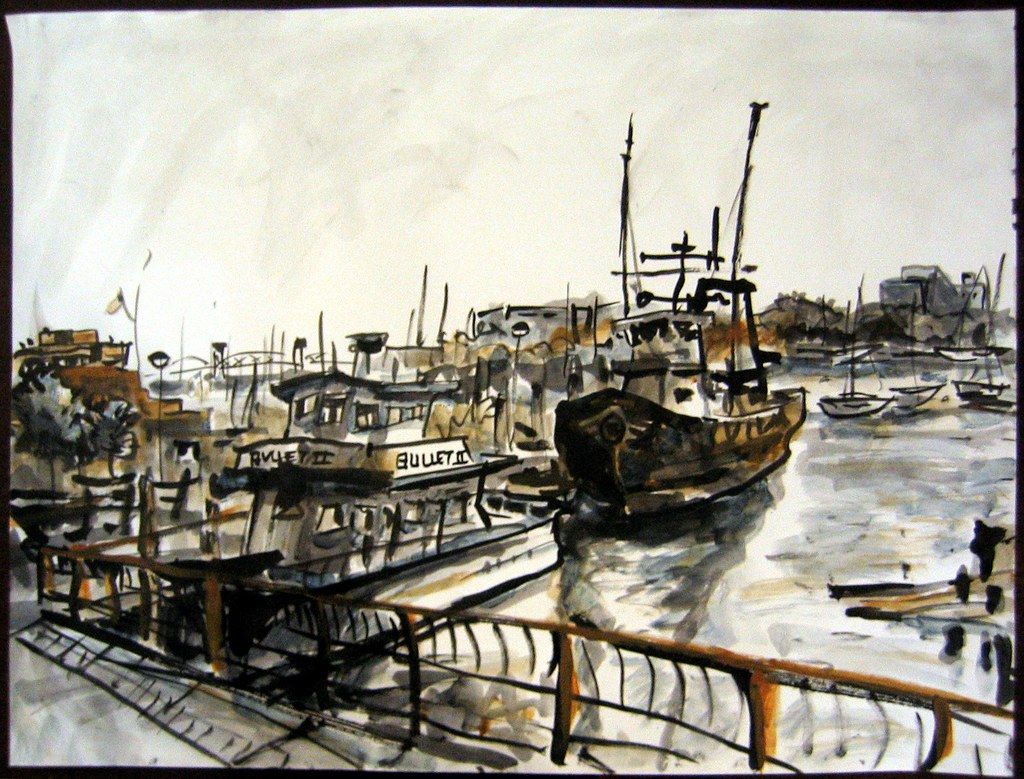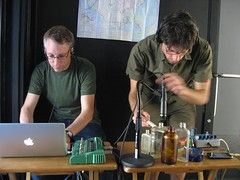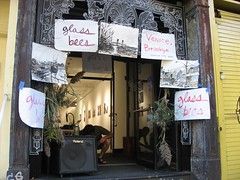Sheepshead Bay Gets Its Close-Up, Avant Garde Style

If you thought traffic was bad at the Sheepshead Bay Road bus stop, teeming with Kingsborough students late for their 9 a.m. class and exasperated espresso fiends tweeting about their frustration, wait until you have to push your way off the back of a gondola.
Oh, you heard right; we said gondola.

New York City’s own Atlantean harbingers in their own right, Christopher Williams and Jason Das of experimental musical project known as the Glass Bees, recently embarked on a morning-long acquisition of a variety of media taken or inspired by the southeastern coast of Brooklyn, including our very own Sheepshead Bay, to form a multimedia experience called Venice, Brooklyn.
Voracious listeners of genre-bending tunes including indie rock, avant garde, and free jazz, Williams and Das are no strangers to the local music scene. Former members of Sick Passengers, the Glass Bees have come to the conclusion that “you don’t have to just compose a song.” After years of working within mainstream conventions, the duo ventured into more abstract work, and have amassed an amazing library of sound prior to their involvement with the 2009 ConfluxCity festival.
The duo decided to participate in the underground music and arts festival, focusing on neighborhoods that the other participants neglected. Noting that New York is larger than just Manhattan, the Glass Bees headed to Gerritsen Beach and Sheepshead Bay because, as Jason so succinctly puts it, “Nobody goes there.” Most of Conflux 2009 took place in Manhattan or northern Brooklyn.
Completed within a span of ten hours on September 20, the Venice, Brooklyn installation came armed with debris collected from our shores, recordings of coast guard frequencies and ambient noise, as well as maps highlighting the areas that would be affected by severe coastal flooding in the coming years.

After being accepted to Conflux, the Bees took a look at projections of sea-level rises and headed to the areas that were under the most significant threat. What was captured in the Venice, Brooklyn soundscape, which can be streamed or downloaded for free at glassbees.com, is a catalog of isolation and the haunting gloom of a mechanical yet incredibly uncomplicated future.
Like the teacher from Charlie Brown, the hazards of inclement weather and the destructive ability of forces beyond human control are heard by residents as a faint din, humming unnoticed in the backgrounds of our daily lives. Most of us falsely believe we are far removed from the effects of global warming and, as stated in a 2007 study,the “twin pressures of development and increasing coastal hazards” – an ignorance highlighted by the swarms of residents moving into newly-constructed condos along our waters. Of course, such heady subject matter is likely inspired by Williams’ work as a science editor
Das, an accomplished artist and contributer to UrbanSketchers.com, created accurate watercolors of the neighborhood to complement the soundtrack and collection of detritus, as well as a slideshow of photographs taken during their foray into dérive. The images are available for viewing on their flickr account. Even their approach to capturing sound was like being a photographer, as they searched for a focal point; “Something specific to hang on to.”
Working under strict time constraints, the team wove completely raw material together to create the ambiance. In the end, their efforts were nearly trashed by the hasty culture of NYC: just two days before Venice, Brooklyn was performed, the Glass Bees’ original performance venue was denied to them.
Citing crazy “last-minute” organization, the artists themselves seem shocked that it pulled together so well. Since much of their material relies on the combination of instruments and looped recording, “editing is a big part,” according to Williams. He also noted that it was “pretty rare” that they’d have the confidence to post it on the web and be satisfied with work done so quickly. After wandering through our neighborhood, they headed back to their apartment to “burn through all the samples” and spent an hour and a half figuring out what was useable. There was no time to second guess themselves.
High-pitched whines of speeding RC cars, dripping water, wind, and rhythmic tapping preface a one-sided conversation detailing the trials and tribulations of acquiring a permit for a remote control car racing club. Crickets and slowed down voices are woven together over crackling and clanging bells. Taking place the very same afternoon it was recorded, created and gathered, Venice, Brooklyn was performed on the stoop of Envoy Enterprises in Chinatown.
Snippets of locals’ discussion loop with nature and transmissions of radio weather reporting, all combining for a twenty-six minute opus of decline. Onlookers were encouraged to come in and listen. Representative of the ongoing evolution of the Glass Bees’ mission, Venice, Brooklyn is not exactly “We Are The World,” but packs a profoundly serious message for New Yorkers.
At the very heart of the Venice, Brooklyn project is hope. Hope that their efforts aren’t contrived simply for an artistic purpose? Hope that the message reaches the right ears? Hope that with a little knowledge, instead of precluding disaster, we can learn to live with it? Hope that more artists and musicians will be interested in working towards something greater and meaningful? Perhaps Christopher Williams says it best on his own blog:
In a small way, Venice, Brooklyn was an attempt to focus on the material reality of what is at risk. Data and statistics can seem abstract to the nonscientist, and it won’t be until people’s lives are impacted in concrete, physical ways that the full extent of the phenomenon will be understood. Although the trends are clear, climatologists admit that the specific effects of climate change are difficult to predict. New York City will have no alternative but to improvise, to adapt to the changing environment in which we find ourselves… perhaps not unlike a certain, transitory multimedia installation presented on a stoop in Chinatown.
Most of Venice, Brooklyn is the result of frustration with a very real problem, and raising awareness is, of course, valuable. Despite that, the Glass Bees do not want to be branded as didactic. Williams and Das spoke at length about how much they enjoyed simply being in our community and absorbing the essence of the environment. Connecting with people is just as much a duty as spreading the underlying message.
Admittedly, not everyone is ready for a speaker blaring out strange noises from a stoop in Chinatown, but that is what evolution is all about. Venice, Brooklyn was the first project the Glass Bees approached as a concept. They had done concerts, shot video, and moved in a specific direction before; but this was different. This “has legs.” They are considering returning to Sheepshead Bay, perhaps even continuing the Venice, Brooklyn project.
You can look forward to more collaborations and performances from the Glass Bees in the future. They’re trying to find a path, “that’s not just noise for noise’s sake.” Music, they said, can mean something. Hoping to get out of town and bring their sound further than the tri-state area, the future is uncertain. What do the Glass Bees want you to know? They’re here. They have a website. They are an active unit. They’re up for collaborating and they’re always tinkering — they meet once a week to record, whether it’s a step forward to engaging the world with something that’s under the radar or just collaborating because it feels good. And sometimes it feels good not knowing what’s going to happen.




